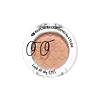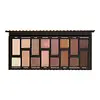What's inside
What's inside
 Key Ingredients
Key Ingredients

 Benefits
Benefits

 Concerns
Concerns

 Ingredients Side-by-side
Ingredients Side-by-side

Talc
AbrasiveMica
Cosmetic ColorantPolymethyl Methacrylate
Silica
AbrasiveMagnesium Myristate
Diisostearyl Malate
EmollientPhenyl Trimethicone
Skin ConditioningHydrogenated Polydecene
EmollientZinc Stearate
Cosmetic ColorantCI 77491
Cosmetic ColorantOctyldodecyl Stearoyl Stearate
EmollientCI 77891
Cosmetic Colorant1,2-Hexanediol
Skin ConditioningCI 77499
Cosmetic ColorantCI 19140
Cosmetic ColorantCI 73360
Cosmetic ColorantGlyceryl Caprylate
EmollientAluminum Hydroxide
EmollientDimethicone
EmollientMethicone
EmollientTriethoxycaprylylsilane
Talc, Mica, Polymethyl Methacrylate, Silica, Magnesium Myristate, Diisostearyl Malate, Phenyl Trimethicone, Hydrogenated Polydecene, Zinc Stearate, CI 77491, Octyldodecyl Stearoyl Stearate, CI 77891, 1,2-Hexanediol, CI 77499, CI 19140, CI 73360, Glyceryl Caprylate, Aluminum Hydroxide, Dimethicone, Methicone, Triethoxycaprylylsilane
Talc
AbrasiveSilica
AbrasivePolymethyl Methacrylate
Dimethicone
EmollientTriethoxycaprylylsilane
Sodium Hyaluronate
HumectantCocos Nucifera Fruit Juice
EmollientCocos Nucifera Oil
MaskingRhododendron Ferrugineum Extract
MaskingDiisostearyl Malate
EmollientGlycerin
HumectantAluminum Hydroxide
EmollientHexyl Laurate
EmollientWater
Skin ConditioningHexylene Glycol
EmulsifyingCaprylyl Glycol
EmollientZinc Stearate
Cosmetic ColorantPhenoxyethanol
PreservativePotassium Sorbate
PreservativeSodium Benzoate
MaskingMica
Cosmetic ColorantCI 77891
Cosmetic ColorantCI 77491
Cosmetic ColorantCI 77492
Cosmetic ColorantCI 77499
Cosmetic ColorantCI 75470
Cosmetic ColorantCI 77007
Cosmetic ColorantCI 19140
Cosmetic ColorantCalcium Aluminum Borosilicate
Octyldodecyl Stearoyl Stearate
EmollientPolybutene
Tin Oxide
AbrasiveSynthetic Fluorphlogopite
Pentaerythrityl Tetraisostearate
EmollientMagnesium Myristate
CI 77510
Cosmetic ColorantCalcium Sodium Borosilicate
CI 77400
Cosmetic ColorantPolysorbate 20
EmulsifyingTalc, Silica, Polymethyl Methacrylate, Dimethicone, Triethoxycaprylylsilane, Sodium Hyaluronate, Cocos Nucifera Fruit Juice, Cocos Nucifera Oil, Rhododendron Ferrugineum Extract, Diisostearyl Malate, Glycerin, Aluminum Hydroxide, Hexyl Laurate, Water, Hexylene Glycol, Caprylyl Glycol, Zinc Stearate, Phenoxyethanol, Potassium Sorbate, Sodium Benzoate, Mica, CI 77891, CI 77491, CI 77492, CI 77499, CI 75470, CI 77007, CI 19140, Calcium Aluminum Borosilicate, Octyldodecyl Stearoyl Stearate, Polybutene, Tin Oxide, Synthetic Fluorphlogopite, Pentaerythrityl Tetraisostearate, Magnesium Myristate, CI 77510, Calcium Sodium Borosilicate, CI 77400, Polysorbate 20
Ingredients Explained
These ingredients are found in both products.
Ingredients higher up in an ingredient list are typically present in a larger amount.
Aluminum Hydroxide is a form of aluminum. It can be naturally found in nature as the mineral gibbsite. In cosmetics, Aluminum Hydroxide is used as a colorant, pH adjuster, and absorbent.
As a colorant, Aluminum Hydroxide may add opacity, or reduce the transparency. Aluminum hydroxide is contains both basic and acidic properties.
According to manufacturers, this ingredient is an emollient and humectant. This means it helps hydrate the skin.
In medicine, this ingredient is used to help relieve heartburn and help heal ulcers.
There is currently no credible scientific evidence linking aluminum hydroxide in cosmetics to increased cancer risk.
Major health organizations allow the use of aluminum hydroxide in personal care products and have not flagged it as a carcinogenic risk at typical usage levels.
Learn more about Aluminum HydroxideCI 19140 is also known as Tartrazine. Tartrazine is a synthetic dye used in cosmetics, foods, and medicine to add a yellow color.
Tartrazine is created from petroleum and is water-soluble.
Some people may experience allergies from this dye, especially asthmatics and those with an aspirin intolerance.
Learn more about CI 19140Ci 77491 is also hydrated iron III oxide. It's sole purpose is to give a red/pink hue to products.
Iron III oxides are classified as inorganic chemicals for coloring.
Synthetically created Ci 77491 is considered safer than those naturally found. This is because the synthetically created version may contain less impurities. Iron oxides are generally non-toxic and non-allergenic.
Learn more about CI 77491Ci 77499 is also hydrated iron III oxide. It is created from mixing red and black iron oxides. This helps give shades of darkness to a product.
Iron III oxides are classified as inorganic chemicals for coloring.
Ci 77891 is a white pigment from Titanium dioxide. It is naturally found in minerals such as rutile and ilmenite.
It's main function is to add a white color to cosmetics. It can also be mixed with other colors to create different shades.
Ci 77891 is commonly found in sunscreens due to its ability to block UV rays.
Learn more about CI 77891Diisostearyl Malate is an emollient and most often used in lip products. It comes from isostearyl alcohol, a fatty acid, and malic acid, an AHA.
As an emollient, Diisostearyl Malate helps create a thin film on your skin to trap moisture in. This helps keep your skin soft and smooth.
Dimethicone is a type of synthetic silicone created from natural materials such as quartz.
What it does:
Dimethicone comes in different viscosities:
Depending on the viscosity, dimethicone has different properties.
Ingredients lists don't always show which type is used, so we recommend reaching out to the brand if you have questions about the viscosity.
This ingredient is unlikely to cause irritation because it does not get absorbed into skin. However, people with silicone allergies should be careful about using this ingredient.
Note: Dimethicone may contribute to pilling. This is because it is not oil or water soluble, so pilling may occur when layered with products. When mixed with heavy oils in a formula, the outcome is also quite greasy.
Learn more about DimethiconeWe don't have a description for Magnesium Myristate yet.
Mica is a naturally occurring mineral used to add shimmer and color in cosmetics. It can also help improve the texture of a product or give it an opaque, white/silver color.
Serecite is the name for very fine but ragged grains of mica.
This ingredient is often coated with metal oxides like titanium dioxide. Trace amounts of heavy metals may be found in mica, but these metals are not harmful in our personal products.
Mica has been used since prehistoric times throughout the world. Ancient Egyptian, Indian, Greek, Roman, Aztec, and Chinese civilizations have used mica.
Learn more about MicaOctyldodecyl Stearoyl Stearate is created from stearic acid.
It is an emollient and thickens the lipid (oil) portion of a product. Due to its emollient properties, it may not be fungal-acne safe.
This ingredient is also known as PMMA. It is a polymer microsphere, composed of tiny, perfectly spherical particles formed from repeating units.
In cosmetics, PMMA is mainly used to give a soft or blurring effect. The transparent particles are able to scatter light and help reduce the appearance of fine-lines and imperfections.
PMMA is also able to enhance the texture of products by add a smooth feel.
Learn more about Polymethyl MethacrylateSilica, also known as silicon dioxide, is a naturally occurring mineral. It is used as a fine, spherical, and porous powder in cosmetics.
Though it has exfoliant properties, the function of silica varies depending on the product.
The unique structure of silica enhances the spreadability and adds smoothness, making it a great texture enhancer.
It is also used as an active carrier, emulsifier, and mattifier due to its ability to absorb excess oil.
In some products, tiny microneedles called spicules are made from silica or hydrolyzed sponge. When you rub them in, they lightly polish away dead skin layers and enhance the penetration of active ingredients.
Learn more about SilicaTalc is a clay mineral. It helps absorb moisture and improve the texture of products. Like other types of clay, Talc can have a slight exfoliating effect on skin. Talc can be added to increase the volume of products.
Some Baby powders are made by combining talc with corn starch. The word "talc" comes from Latin and originates from Arabic. Talc is a mineral commonly found throughout the world.
If you have any concerns about using talc, we recommend checking out the FDA's official page.
Learn more about TalcTriethoxycaprylylsilane is a silicone used to bind and stabilize ingredients.
As an emulsifier, it helps prevent ingredients from separating. This can help elongate the shelf life of products.
Triethoxycaprylylsilane is often used to coat mineral sunscreens ingredients to help give a better feel. It also helps reduce oxidative stress in sunscreens.
Learn more about TriethoxycaprylylsilaneZinc Stearate is the metal salt of stearic acid. It is a white solid used to bind, thicken, and lubricate products.
This ingredient is common in powder makeup, where it helps keep the powder together.
Zinc Stearate is hydrophobic and repels water.
This ingredient can be sourced from non-animal or animal sources. It is best to reach out to the brand to see where they source this ingredient from.
Learn more about Zinc Stearate